
|
Sale 114
The New York Sale
| Great Britain The Neil Smith Collection |
| |
| |
| Lot |
Photo |
Description |
Bidding |
Lot 478 |
 |
Alfred the Great (871-899), Silver Penny, portrait type, third coinage (c.880-899), London Mint. Diademed portrait facing right, wearing tunic made up of curved horizontal lines with pellets, legend and outer beaded circle at rim surrounding, legend commences at left, + ÆLFR ED REX, rev. the Londinia Monogram, cross pattée above, triangle of six pellets below, outer beaded circle surrounding, weight 1.53g (B.M.C. type VI; Mackay London A5, 16.1 this coin; N.644; S.1061). Attractively toned, well centred, almost extremely fine with a superb portrait, very seldom seen this well preserved. Value $12,500 - UP
The portrait silver Penny with the monogram of Londinia on the reverse has always been the most desirable type coin of Alfred for any collector to attain in their collection. The example demonstrated here has an exceptionally well detailed portrait and reverse. For further reference see "The London Monogram Coinage of Alfred the Great and the Danelaw" by William A. Mackay, British Numismatic Journal, volume 89, 2019, pages 19-107 where this coin is listed in the corpus as London A, type A5, die combination 16, over 8, reverse 18.
The obverse Latin legend translates as "Alfred King" on this superb portrait Penny which is coupled with the Londinia Monogram, the most desirable type of all the Alfred the Great Pennies.
Ex Rev. William Lewis Gantz, part II, Glendining, 23-27th June 1941, lot 1029. Ex Spink Numismatic Circular, October 1983, item 6652. Ex Lawrence R. Stack Collection, Sotheby, 22nd April 1999, lot 436. Ex Spink Numismatic Circular, December 2000, HS0006.
View details and enlarged photos
|
|
Lot 479 |
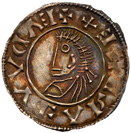 |
Edward the Elder (899-924), Silver Penny, portrait type, Moneyer Tila. Crude draped diademed bust left, retrograde Latin legend with inner linear and outer beaded circles surrounding, legend commences upper left in retrograde +EADVVEARD REX, rev. three cross pattées across centre, three pellet triangle at top and bottom of centre, Moneyer name in two lines, TILI M / ONETA, the last two letters inverted, weight 1.72g (S.C.B.I. 20:751 this coin; B.M.C. type III, N.651; S.1084). Attractively toned, obverse well centred, a touch of excess metal to rim, an intriguing piece with the retrograde obverse legend and inverted letters on reverse, almost extremely fine with an excellent provenance, very rare. Value $5,000 - UP
For further reference see article "The Vatican Hoard of Anglo-Saxon Pennies" by M. A. O'Donavan, British Numismatic Journal 1964, pages 7-29, this coin listed in running order as 451, catalogue number B54. It is interesting to note this hoard contained only four Edward the Elder pennies of the moneyer Tila, and this was the only piece with the unusual retrograde legend. The hoard was found some time in 1928 purportedly on the Vatican Wireless site then under construction, and consisted of 517 Anglo-Saxon pennies in total, of which 437 were of King Edward the Elder and the majority went for auction in two parts through Glendining in London through 1929 and 1930.
The obverse Latin legend translates as "Edward King" and the reverse as "Tila Moneyer.".
Ex Vatican, Rome Hoard, Glendining, part II, 13th November 1930, lot 54. Ex Richard Cyril Lockett, English Collection part III, Glendining, 4-8th November 1958, lot 2713, sold for £38. Ex Commander Richard Paston Mack, part I, Glendining/Spink, 18th November 1975, lot 117. Ex Spink Numismatic Circular, December 2000, HS0007.
View details and enlarged photos
|
|
Lot 480 |
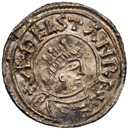 |
Aethelstan (924-939), Silver Penny, portrait type, Norwich Mint, moneyer Hrodgar. Crowned and draped bust right extending to bottom of coin, legend with inner and outer linear circles surrounding, outer beaded border on rim both sides, legend commences at left, + ÆÐELSTAN REX, rev. cross pattée at centre, legend with inner and outer linear circles surrounding, + HRODGAR MO NORDI:, weight 1.51g (B.M.C. type VIII; N.675; S.1095). Toned, almost extremely fine with a pleasing portrait. Value $3,000 - UP
According to North the Norwich Mint is one of thirteen different mints mentioned on coins of this portrait type of Aethelstan and Hrodgar is one of seven moneyers working at this mint at this time which would suggest it was the second most important mint as a hub of activity in East Anglia, after London which had ten different moneyers. It is interesting to note that Norwich did not seem to contribute to the more prolific earlier circumscription cross non-portrait pennies issued earlier in the reign.
The obverse Latin legend translates as "Aethelstan King" and the reverse as "Hrodgar Moneyer of Norwich.".
Purchased from Spink and Son Ltd. 5th March 2002.
View details and enlarged photos
|
|
Lot 481 |
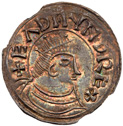 |
Eadmund (939-946), Silver Penny, portrait type, East Anglian style, Norwich Mint, Moneyer Manen. Crowned and draped bust right extending to bottom of coin, legend with linear inner circle surrounding, toothed border around rim, legend commences at left, +EADMVND REX, rev. small cross pattée, legend with linear inner circle surrounding, +MANEN MO NORDE, the Ms and NS quite H like, weight 1.45g (B.M.C. type VI; N.698; S.1107). Toned with an attractive portrait, outer rim just a little chipped, good very fine and rare with the mint reading. Value $5,000 - UP
Though there are many moneyers operating in the reign of Eadmund across a number of different coinages in this seven year reign, according to North there is only one proven mint in operation at Norwich for the portrait coinage. Manen was one of six moneyers at this East Anglian town for these portrait coins. The only other suggested mint named pieces with a portrait are from three different moneyers whose Pennies give a B mint signature, which might be Bedford. There are some non-portrait coins issued with Chester, Wallingford and perhaps Derby mint signatures.
The obverse Latin legend translates as "Eadmund King" and the reverse as "Manen Moneyer of Norwich.".
Ex Sotheby, 8th October 2001. Ex Davissons, Cold Spring Minnesota, List 86, November 2001. Ex Lucien La Riviere, Spink Coin Auction, 10th October 2002, lot 1002.
View details and enlarged photos
|
|
Lot 482 |
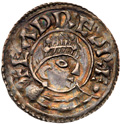 |
Eadred (946-953), Silver Penny, portrait type, moneyer Levvince. Crowned and draped bust right extending to bottom of coin, legend with linear inner circle surrounding, toothed border around rim both sides, legend commences at left, + EADRED RE., rev. small cross pattée, legend with linear inner circle surrounding, LEUUINCE ONX.:, weight 1.40g (B.M.C. type V; N.713; S.1115). Very attractively toned, with an excellent portrait, almost extremely fine, the moneyer name interesting as the "VV" is depicted on this coin unusually as "UU", very rare. Value $5,000 - UP
The seven year reign of Eadred does not usually give us any mint town readings. Therefore, it is interesting to note in the Lockett catalogue entry it was suggested that the ON X part of the legend may mean Exeter mint, though with modern thinking since it is more likely the X and three pellets following the N are space fillers. The Lockett cataloguer also thought the moneyer name to be LEMLINCE rather than Levvince. In the Witte catalogue of 1908 the cataloguer gives the moneyer name as LEMOINCE.
This coin is illustrated in the book "Coinage in Tenth Century England" by Messrs. Blunt Stewart and Lyon, plate 24 number 250.
The obverse Latin legend translates as "Eadred King" and the reverse as "Levvince Moneyer.".
Ex Julius Witte, of Altrincham, Sotheby, 13th April 1908, lot 55. Ex Richard Cyril Lockett, English Collection part IV, Glendining, 26-27th April 1960, lot 3701, sold for £62. Ex Lucien La Riviere, Spink Coin Auction, 10th October 2002, lot 1003.
View details and enlarged photos
|
|
Lot 483 |
 |
Eadwig (955-959), Silver Penny, non-portrait type. North Eastern York group with large lettering, two-line type, moneyer Heriger, small cross pattée, legend with inner and outer linear circles surrounding, outer beaded border around rim both sides, legend commences upper right, +EADPIG REXO, rev. three cross pattées across centre, tri-pellets above and below moneyer name in two lines, HERIG / ER MO, linear outer circle surrounding, weight 1.17g (B.M.C. type I; N.724 HT 1 NE; S.1122). Outer rim chipped a little chipped with one short hairline flan split, otherwise toned, good very fine. Value $1,500 - UP
This is the only non-portrait coin in this 57-coin run of Kings and Queens, and for good reason as no portrait pennies are currently available to the marketplace. All the known portrait pieces of Eadwig are from London Mint or the North East, and there are no more than perhaps four examples known with all such portrait coins being currently held in museum collections.
From the style of this coin with its larger lettering and the King�s name styled as EADPIG it is thought that Heriger is moneyer possibly emanating from York.
The obverse Latin legend translates as "Eadwig King" and the reverse as "Heriger Moneyer.".
Ex Joseph Cox, Sotheby, 6th April 1892 Ex Lord Grantley, third portion of collection, Glendining, 22nd March 1944, lot 1083. Ex W. H. Bennett, Glendining, 4th October 1972, lot 627. Ex Seaby Coin and Medal Bulletin, December 1972, item H3368. Ex Collection of coins illustrated in "Silver Heads, Royal Tales" by A. L. T. Maccammon, Baldwin Auction 80, 8th May 2013, lot 2186.
View details and enlarged photos
|
|
Lot 484 |
 |
Eadgar (959-975), Silver Penny, Pre-Reform portrait type (959-c.972), moneyer Sadutinc. Crowned and draped bust right extending to bottom of coin, legend and linear inner circle surrounding, toothed border around rim both sides, legend commences at left, + EADGAR REX, rev. small cross pattée, legend and linear inner circle surrounding, +SAVDTINC+ MONVNI, weight 1.38g (B.M.C. type V; N.750; S.1138). Very attractively toned, some old toned short hairline scratches on middle of reverse, otherwise with a superb portrait, almost extremely fine, one of the more unusual moneyer names, very rare. Value $5,000 - UP
The moneyer Sadutinc as given in North is depicted on this coin as "Saudtinc", and the reading continues with an unusual lengthy moneyer reading as "Monvni" and with an extra cross after the moneyers name. We note in North that an uncertain mint reading possibly for Huntingdon is rendered as "VN" on the coins, perhaps this coin could be a possibility as this mint reading. North lists the moneyer for "VN"as Dudinc which is not dissimilar to Saudtinc.
In the Pre-Reform portrait coinage of King Eadgar North lists some 22 moneyers including Sadutinc who did not give a mint signature, whereas he lists 25 moneyers who are connected with a mint including Dudinc mentioned above.
The obverse Latin legend translates as "Eadgar King" and the reverse as "Saudtinc Moneyer.".
Found Costessey Norfolk, 2000. Ex Spink Numismatic Circular, December 2000, HS0010, illustrated on front cover (also appeared in an article published in Minerva Magazine around this time).
View details and enlarged photos
|
|
Lot 485 |
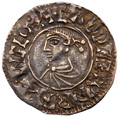 |
Edward the Martyr (975-978), Silver Penny, London Mint, Moneyer Leofstan. Draped diademed portrait left, legend with inner linear circle and outer beaded circle surrounding, legend commences at top, +EADPEARD REX ANGLORX, last two letters ligatured, rev. small cross pattée, legend with inner linear circle and outer beaded circle surrounding, +LEOFSTAN MON LVN:, weight 1.28g (B.M.C. type I; N.763; S.1142). Toned, seemingly struck from a worn reverse die, soft strike on the high points, otherwise with a detailed portrait, very fine, the moneyer name not listed by North, therefore rare. Value $3,000 - UP
The only type of Penny for Edward the Martyr is the portrait coin with all mentioning a mint town on the reverse. There are 35 mint towns recorded by North for this reign with at least five other more mysterious readings that are unallocated. It is interesting to note that North does not list a Leofstan for London, but only a similar Leofeh amongst the total of six names for this mint. In this reign the number of moneyers was actually greater at Lincoln with ten, and Stamford with fourteen, but the most are recorded at York with fifteen.
The obverse Latin legend translates as "Edward King of the English" and the reverse as "Leofstan Moneyer of London.".
Ex Viking Collection, Spink Coin Auction 150, 14th March 2001, lot 1007.
View details and enlarged photos
|
|
Lot 486 |
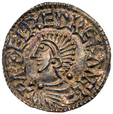 |
Aethelred II (978-1016), Silver Penny, long cross type (c.997-1003), Exeter Mint, Moneyer Manna. Draped bust left, large pellet at nape of neck, legend and outer beaded border surrounding, legend commences lower left, +ÆÐELRÆD REX ANG, rev. long voided cross with tri-crescent ends, legend and outer beaded border surrounding, +MA NNA M.O E AXE, pellet in O, weight 1.41g (B.M.C. type Iva; N.774; S.1151). Dark attractive tone, two small peck marks on reverse, otherwise extremely fine. Value $600 - UP
Aethelred II issued nine types of silver Penny throughout his long 38-year reign as there was a veritable explosion in the number of mints and activity of their moneyers. According to North there are a total of up to 73 mints operating in this reign with a further 14 enigmatic readings that are uncertain. Six of the coin types including long cross, ran for six-year periods with the other three being much more short-lived. The long cross type spanned the turn of the eve of the first Millennium in 1000 and the Exeter Mint at that time had up to 33 moneyers working as a key town to supply money for commerce in the West Country. The only mints that had more moneyers were Stamford with 37, Winchester with 44, Lincoln with up to 65, York with up to 82, and the lion�s share in the capital of London with up to 102 in operation.
The obverse Latin legend translates as "Aethelred King of the English" and the reverse as "Manna Moneyer of Exeter.".
Ex Hermann Vogel Collection, Adolph Hess, Frankfurt, 16th April 1928, lot 4580. Ex R. A. Shuttlewood, Spink Coin Auction 151, 15th March 2001, lot 467.
View details and enlarged photos
|
|
Lot 487 |
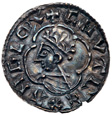 |
Canute (1016-35), Silver Penny, quatrefoil type (c.1017-23), Ipswich Mint, Moneyer Edric. Crowned and draped bust left within quatrefoil, legend and outer beaded border surrounding, legend surrounding commences at top, +CNVT REX ANGLORX, last two letter ligatured, rev. pellet at centre of voided long cross, over quatrefoil with pellet cusps, legend and outer beaded border surrounding, +ED RIC M?O GIP, weight 1.03g (B.M.C. type VIII; N.781; S.1157). Attractive dark tone, one small rim chip, otherwise extremely fine, a popular East Anglian mint. Value $750 - UP
Despite Canute being essentially a Viking King from overseas, the coinages of England continued in a similar vein to those of Aethelred II, in that the types changed every six years, meaning there are three main types for this reign, of which the quatrefoil type was the first. According to North there were up to 74 mints in operation with perhaps four other enigmatic places that remain uncertain. Ipswich operated with up to sixteen moneyers in this reign which is about seven times less than London for instance and twelve less than the regional monetary center of Thetford in East Anglia.
This Quatrefoil type coin is struck from the regional die cutting centre of Thetford of type A late style, as defined by Mark Blackburn and Stewart Lyon in their article "Regional Die-Production in Cnut's Quatrefoil Issue" a chapter in "Anglo-Saxon Monetary History" edited by M. A. D. Blackburn published 1986.
The obverse Latin legend translates as "Canute King of the English" and the reverse as "Edric Moneyer of Ipswich.".
Ex Captain Peter Arnot, Dix Noonan and Webb, 21st March 1995, lot 192. Purchased from Spink and Son Ltd, 24th January 2001.
View details and enlarged photos
|
|
Lot 488 |
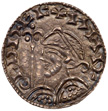 |
Harold I (1035-40), Silver Penny, fleur de lis type (c.1038-40), London Mint, moneyer Brittmaer. Diademed bust left with sceptre, legend and outer beaded border surrounding, legend surrounding commences at top, +HAR OLD REI:, rev. pellet at centre of voided long cross, pellet topped fleur de lis between pellets in each angle, legend and outer beaded border surrounding, +BR IHT: MÆR O LV, weight 1.03g (B.M.C. type V; N.803; S.1165). Well struck and centred, toned, extremely fine. Value $1,500 - UP
The London mint being the capital at this time, had according to North the most moneyers in active operation with up to 119 under King Canute alone, this being the greatest number for any mint in the Anglo-Saxon period. North records a reduction in London striking coins for Harold due to the joint nature of the reigns to 42 which is a good deal more than the 24 working on dies for Harthacanute. Lincoln was the next most prolific for Harold with up to 31 moneyers followed by jointly Winchester and York with up to 21 moneyers. This coin is from the latter fleur de lis reverse type issued in this reign.
The obverse Latin legend translates as "Harold King" and the reverse as "Brihtmaer of London.".
Ex Ross Blakey Collection, Canada, this coin sold privately to Spink. Purchased from Spink and Son Ltd, 8th March 2001.
View details and enlarged photos
|
|
Lot 489 |
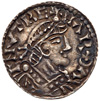 |
Harthacanute (1035-42), Silver Penny, jewel cross type (Spring-Autumn 1036), Canterbury Mint, Moneyer Windraed. Diademed bust right extending to bottom of coin, legend and outer beaded border surrounding, legend commences at top with full name, +HARÐA CNVT RE, rev. cross of four lobed jewels with pellet centre, united at their base by a double annulet, pellet at centre, legend and outer beaded border surrounding, +PINEDI ONN CENT., weight 1.10g (B.M.C. type I; N.809; S.1166). Attractively toned, two tiny peck marks on reverse, otherwise good very fine with a great portrait in the full name of this King. Value $6,000 - UP
The Jewel cross type reverse is the first type for this reign concurrent with that for Harold I, and the Canterbury Mint in Kent had according to North only up to five moneyers issuing for Harthacanute, though four of these also worked dies in Harold�s name with the mixed allegiance to Kingship at this time. As Harthcanute was absent for much of the reign, moneyers working dies in his full name are far fewer than for the shorter reign of Harold. There were only greater numbers of moneyers producing dies for Harthacanute in ascending order at Exeter (8), Gloucester (8), Oxford (8), Chester (9), Stamford (10), Winchester (12), Lincoln (23), London (24).
The obverse Latin legend translates as "Harthacanute King" and the reverse as "Windraed of Canterbury.".
Purchased from Spink and Son Ltd, 7th June 2002.
View details and enlarged photos
|
|
Lot 490 |
 |
Edward the Confessor (1042-66), Silver Penny, hammer cross type (1059-62), Chichester Mint, Moneyer Godwine. Crowned and draped bust right with sceptre, bust extends to bottom of coin, legend commences at top with beaded border surrounding, +EADPAR RD RE, rev. pellet in centre of voided cross with hammer pellet terminals, legend and beaded border surrounding, +GODPINE ON CICEIT:, weight 1.35g (B.M.C. type XI; N.828; S.1182). Attractively toned, a touch weak in parts of reverse legend, with an excellent depiction of the King, extremely fine. Value $750 - UP
During the reign of Edward the Confessor the coinage types were now regulated to change on a two to three yearly basis. The hammer cross type pennies are the penultimate issue of the reign and according to North the Chichester Mint in Sussex was one of the smaller mints in operation at that time with only up to four moneyers working the dies. Quite miniscule when compared to the 84 working in London, the 41 located in York or the 39 in Lincoln.
The obverse Latin legend translates as "Edward King" and the reverse as "Godwine of Chichester.".
Ex Spink Numismatic Circular, February 2001, HS0097 also illustrated in color inside front cover.
View details and enlarged photos
|
|
Lot 491 |
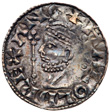 |
Harold II (6th Jan-14th Oct 1066), Silver Penny, Pax type, Lewes Mint, Moneyer Oswold. Crowned bust left with sceptre, legend and outer beaded border surrounding, legend commences at upper right, +HAROLD REX ANG, rev. PAX between beaded lines horizontal at centre, legend with inner and outer beaded border surrounding, legend commences at lower left +OZPOLD ON LEPEEI, weight 1.34g (B.M.C. type I; N.836; S.1186). Attractively toned, with a pleasing portrait, almost extremely fine. Value $3,500 - UP
The short reign of Harold II seems to see a reduction in the number of mints and moneyers in operation, though with the recent find in the Chew Valley in Somerset of a hoard of Harold II and William I coins, numismatists are waiting with baited breath to see what new expansion of such data can be garnered from further study, as the hype of new types and mints apparent in the hoard have caused great excitement. According to North the Lewes Mint in Sussex only had three moneyers for Harold II as opposed to fifteen for his predecessor Edward. As of the publication of North most mints show only such small numbers active, with the most actually at York with up to twelve and Lincoln and London tying for second place with eight moneyers each. Gloucester and Cambridge tie for third with six moneyers apiece. The only type known and available to commerce at present, is the PAX type on account of the short reign culminating in the Battle of Hastings, unless the Chew Hoard contains new types not seen before which more than likely would end up institutionalized.
The obverse Latin legend translates as "Harold King of the English" and the reverse as "Oswold of Lewes.".
Ex Collection of a Married Couple, Bowers and Merena, 15-17th March 2001, lot 3535. Purchased from Spink and Son Ltd, 26th April 2001.
View details and enlarged photos
|
|
Lot 492 |
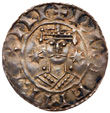 |
William I (1066-87), Silver Penny, two stars type (1074-77?), Bristol Mint, moneyer Leofwine. Facing crowned bust with star each side, all within linear circle, legend commences at top with outer beaded circle surrounding, +PILLEM REX AI, rev. annulet at centre of cross bottonnée, over quadrilateral with incurved sides, legend with inner linear and outer beaded border surrounding, +LEPINE ON BRIC, weight 1.36g (B.M.C. type V, cf.299-300; N.845; S.1254). Toned, a little weak in parts though with a good face, good very fine. Value $1,000 - UP
Despite the transition from the Anglo-Saxon to the Norman period, numismatically the three-year change of coin types continued. The two stars type on account of the star depicted either side of William is the fifth of the seven types attributed to this reign. According to North the Bristol Mint in Somerset had up to eight moneyers active throughout the reigns of William the Conqueror and William Rufus, which is one of the lower numbers amongst the mint activity at this time. London was the main mint with up to 38 moneyers, with Lincoln second with up to 26 and Norwich third with up to 18.
The obverse Latin legend translates as "William King of the English" and the reverse as "Leofwine of Bristol.".
Ex Spink Numismatic Circular, February 2001, HS0102 also illustrated in color inside front cover.
View details and enlarged photos
|
|
Lot 493 |
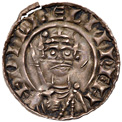 |
William II (1087-1100), Silver Penny, cross in quatrefoil type (1089-92?), London Mint, Moneyer Bruninc. Facing crowned bust to edge of coin with sword resting on shoulder, legend commencing lower left with inner linear and outer beaded circles surrounding, +PILLELMI REI, rev. cross pattée in quatrefoil, pellet in each inner angle, legend commencing at top with inner linear and outer beaded circles surrounding, +BRVNIC ON LVND, the last two letters ligatured, weight 1.34g (BMC type II, 106; N.852; S.1259). Well struck and toned, one small peck mark in obverse field, a little excess metal on one part of rim, otherwise with a super portrait of William Rufus, almost extremely fine. Value $2,500 - UP
The three-year cycle in changing coin types continues through the reign of William Rufus, with the cross in quatrefoil reverse type being the second of five types. The most populous mint for moneyer activity at this time, the London mint operated up to 38 moneyers through the reigns of William I and William II.
The obverse Latin legend translates as "William King" and the reverse as "Bruninc of London.".
Ex Lawrence R. Stack Collection, Sotheby, 22nd April 1999, lot 646. Ex Spink Numismatic Circular, December 2000, HS0031, illustrated on front cover.
View details and enlarged photos
|
|
Lot 494 |
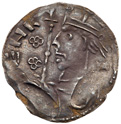 |
Henry I (1100-35), Silver Penny, double inscription type (c.1115), London Mint, moneyer Rauf. Crowned bust with diadem and sceptre facing left, two quatrefoils of annulets before sceptre, legend surrounding with outer beaded border commences lower left, -ENR---, rev. cross patte at centre in circle, two concentric legends with inner beaded circles surrounding, the outer legend divided by four quatrefoils of annulets in circles, moneyer in outer legend, +R AV LF ON, mint name on inner circle in full, +LVNDEN, weight 1.31g (BMC type XI, cf.77; N.867; S.1272). Toned, a little weakly struck in parts as usual mainly on outer legend, with a super portrait not often seen for these poorly made issues, very fine, but the portrait better, rare as such. Value $1,250 - UP
According to North the change of coin types becomes more sporadic in this reign with quite frequent changes at the start on a two-yearly basis becoming less so later on with fifteen types across the reign. The last and most common type being issued for up to a decade. The double inscription type is thought to be the eleventh in the sequence and may have lasted up to two years in production. One of the more attractive types of this reign the coinage carries a more life-like depiction of the King than others at this time and is perhaps one of the more desirable to attain for a collector. The London Mint at this time had up to 41 moneyers working the dies, more than double of any other mint with Winchester running second with 20 moneyers, followed by East Anglian Norwich and Thetford with 19 moneyer apiece.
The obverse Latin legend translates as "Henry King" and the reverse as "Raulf of London.".
Purchased from Spink and Son Ltd, 17th July 2001.
View details and enlarged photos
|
|
Lot 495 |
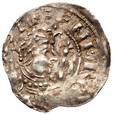 |
Stephen (1135-54), Silver Penny, Watford type (c.1136-45), Chichester Mint, Moneyer Godwine. Crowned bust with sceptre right, legend commences left with inner and outer beaded border surrounding, +STIEFNE R-, rev. cross moline, lis in each angle, legend with inner outer beaded border surrounding, +GOD---E: ON: CICE:, weight 1.41g (BMC type I, 26; N.873; S.1278). Toned with a nice clear portrait, only a slight irregularity to shape and a little weak in parts of legend, better than usually encountered, good very fine. Value $1,500 - UP
The reign of Stephen is perhaps one of the most interesting numismatically as England descends towards Civil War in the latter part of the reign, with an increasing volume in types of coinage, with many poorly struck as allegiances to the King, the Empress or the various noblemen wax and wane. The first so-called Watford type is the most abundant, due to the fact that a major hoard of this type turned up in the Watford area in Victorian times, rather than being named after something describing the design, and a well struck piece is hard to find. The Chichester Mint in Sussex remained a smaller mint according to North with perhaps three moneyers active, though Godwine is the only one currently recorded for Stephen; The lion�s share of mint activity was in London and Norwich which each had up to 24 moneyers, followed by Lincoln with up to twelve and in joint third with up to ten at Ipswich and York.
The obverse Latin legend translates as "Stephen King" and the reverse as "Godwine of Chichester.".
Ex Pimprez Hoard, discovered 2002 near Beauvais France, 569 coins and 12 ingots, one of 72 coins of Stephen. Ex Spink Numismatic Circular, December 2004, item HS1885.
View details and enlarged photos
|
|
Lot 496 |
 |
Henry II (1154-89), Silver Penny, short cross type (1180-89), class Ib, London Mint. Moneyer Davi, facing crowned head with linear collar, hand holding sceptre at left, legend with inner linear outer beaded border surrounding, commences upper left, hENRICVS. R EX, rev. short voided cross pommée, small cross pommée in each angle, legend surrounding with inner and outer beaded border, +DAVI. ON. LVND, weight 1.39g (Mass 264; N.963; S.1344). Attractively toned, well struck with reverse just a touch off-centre, good very fine. Value $150 - UP
King Henry II introduced a new type of coinage at the start of his reign entitled the "Tealby" coinage, so named as the largest group ever found of these coins was at Tealby in Lincolnshire in 1807. The King depicted with sceptre on one side, with a short cross pattée on the reverse, with smaller saltire crosses in the inner angles, and with legend surrounding. A further development of that kind of reverse is the short cross type with a cross pomée reverse and a small cross pomée in each angle. The short cross coinage then ran from the last decade of this reign, right through the reigns of Richard I and John and into the first half of the long reign of Henry III, until about 1247, about 67 years, a far cry from the regular changes of the past, and much more of a standardization. A series of classes and sub-classes have been defined in over 150 years of study, with class 1 only for the reign of Henry II with three sub-classes, the first of which divides into five varieties. For further reading consult "The J. P. Mass Collection of English Short Cross Coins 1180-1247" part of the sylloge series. The short cross coinage of Henry II emanates from eleven different mints with London having the most activity with up to twenty moneyers. The obverse Latin legend translates as "Henry King" and the reverse as "David of London.".
Purchased from Spink and Son Ltd, 8th March 2001.
View details and enlarged photos
|
|
Lot 497 |
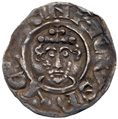 |
Richard I (1189-99), Silver Penny, short cross type, class III, Canterbury Mint, moneyer Reinald. Facing crowned bust with sceptre outside inner linear circle, legend with inner linear outer beaded border surrounding, commences upper left, hENRICVS R EX, rev. short voided cross pommée, cross pommée in each angle, legend surrounding with inner and outer beaded border, +REINALD. ON. CA, weight 1.42g (Mass 751; N.967; S.1347). Toned well centred, just a little irregular in shape from striking and with consequent weakness on reverse rims, a pleasing portrait, very fine. Value $250 - UP
All of the coins dating to the reign of Richard I by class, are depicted in the name of his Father King Henry II as are those of his brother, King John who succeeds him. The short cross coinage continues in the same vein with classes 2, 3 and 4 for this ten year reign, with the latter divided into three sub-classes and the first of those with two varieties. The Canterbury Mint opens for the first time for this coinage at the start of this reign and soon has more activity than London with up to ten moneyers in operation as opposed to seven active in London.
For further reading consult "The J. P. Mass Collection of English Short Cross Coins 1180-1247" part of the sylloge series. The short cross coinage of Henry II emanates from eleven different mints with London having the most activity with up to twenty moneyers. The obverse Latin legend translates as "Henry King" and the reverse as "Reinald of Canterbury.".
Purchased from Spink and Son Ltd, 8th March 2001.
View details and enlarged photos
|
|
Lot 498 |
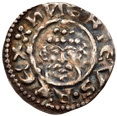 |
John (1199-1216), Silver Penny, short cross type, Rhuddlan Mint Wales (1190-1215), group I class ii, moneyer Tomas. Facing crowned head with linear collar, hand holding sceptre at left, legend with inner linear and outer beaded border surrounding, commences upper left, hNERICVS. R EX, the N retrograde, rev. short voided cross pommée, small cross pommée in each angle, initial mark trefoil of pellets, legend surrounding with inner and outer beaded border, +TOMAS. ON. RVLA, the N retrograde, weight 1.19g (Mass 2175; N.972/2; S.p.167). Once lightly cleaned, now toned and well struck for this distinctive localised issue, good very fine and rare. Value $750 - UP
All of the coins dating to the reign of John by class, are depicted in the name of his Father King Henry II as are those of King Richard I who preceded him. The Rhuddlan Mint in Wales operates throughout the reigns of Henry II to John but does not follow the established classes of the other coinages of the Kingdom having its own local style which is split into two groups with Tomas operating only in group one along with Halli and Simond, the latter being the only moneyer to cross into group II joined by a new moneyer Henricus. We note the Mass Collection coin of this variety was pierced.
For further reading consult "The J. P. Mass Collection of English Short Cross Coins 1180-1247" part of the sylloge series. The short cross coinage of Henry II emanates from eleven different mints with London having the most activity with up to twenty moneyers.
The obverse Latin legend translates as "Henry King" and the reverse as "Tomas of Rhuddlan.".
Ex Spink Numismatic Circular, April 2003, HS1210.
View details and enlarged photos
|
|
Lot 499 |
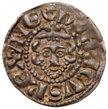 |
Henry III (1216-72), Silver Penny, voided long cross type, class 1b / class 2a mule (c.1248), London Mint. Moneyer Nicole, facing crowned head, legend commences at top with inner and outer beaded border surrounding, initial mark star over crescent, *hENRICVS REX. ANG, rev. long voided cross pommée, trio of pellets in each angle, legend surrounding with inner and outer beaded border, NIC OLE ON L VND, weight 1.45g (N.984/985; S.1360). Toned, well struck with reverse a little off-centre, otherwise almost extremely fine. Value $200 - UP
In an effort to curtail clipping of the edges if coins, Henry III was the first to introduce a coinage where the reverse cross extended to towards the rim of the coin, so any tampering of the edge would be more obvious to the casual observer. The new design having a voided cross pommée with groups of three pellets in each inner angle. The coinage running for a 32 year period from 1247 until 1279 in the reign of Edward I.
The London Mint operated with up to eleven moneyers which was one more than the ten at Canterbury and run through five different classes in this reign with multiple sub-classes and varieties, transitioning into two more later classes in the reign of Edward I. For further reading consult "The Brussels Hoard of 1908, the Long Cross Coinage of Henry III" by Ron Churchill and Bob Thomas � B.N.S. publication No.9.
The obverse Latin legend translates as "Henry King of the English" and the reverse as "Nicole of London.".
Ex Spink Numismatic Circular, December 2003, HS1424.
View details and enlarged photos
|
|
Lot 500 |
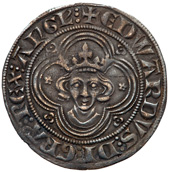 |
Edward I (1272-1307), Silver Groat of Fourpence, new coinage (1279-1307), London Mint. Variety e, Fox class 4, facing crowned bust within triple quatrefoil, bushy hair with neat broad face, wide crown with spearhead ornaments, round drapery at neck, pierced cinquefoil either side of head, three petal flower in each spandrel, legend with beaded inner and outer circle surrounding, triple pellet stops, initial mark cross pattée, +EDWARDVS: DI: GRA: REX: AnGL':, rev. long cross pattée, tri-pellets in each inner angle, double concentric legends and beaded circles surrounding, Lon Don IA C IVI inner legend, outer legend continues titles from obverse with colon stops, :DN�S hIbn E DVX AQVT�, weight 5.51g (S.C.B.I. 39:12; N.1006; S.1379E). Attractive dark tone, well struck with a delightful portrait, for this rare first coinage of the Groat as a new denomination, almost extremely fine and one of the finer examples in private hands, very rare thus. Value $15,000 - UP
Notoriously hard to find well struck and in a good state of preservation as demonstrated herewith, such coins though not an initial success in commerce were greatly revered by the Christian pilgrims who would often mount or gild such pieces of Edward I. The majority of surviving examples in private hands are therefore not as well preserved as the coin offered here. A major new coinage was embarked upon in 1279 which introduced the new "Groat" worth Fourpence weighed 89 grains, the name coming from the similar sized coin in France the "Gros". As more than thirty obverse dies were used alone a number of classes and sub-varieties again have been delineated over the years, in line with classes 1 to 3 of the Penny series. Another administerial measure introduced at this time was the abandonment of the name of the moneyer, as mint activity became more centralized and with provincial mints only assisting for the first two years of the new coinage, at which point from 1281 only London, Canterbury, Durham and Bury continue with minting.
The obverse Latin legend translates as "Edward by the grace of God, King of England" and the reverse as "Lord of Ireland, Duke of Aquitaine" in the outer legend, with the inner legend as "City of London.".
Ex G. C. Palmer special collection. Purchased from Spink and Son Ltd, 14th March 2002.
View details and enlarged photos
|
|
Lot 501 |
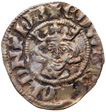 |
Edward II (1307-27), Silver Penny, long cross type, Canterbury Mint, class 11b (c.1310-14). Facing crowned bust in beaded circle, pellet eyes, legend with inner and outer beaded border surrounding, small letters with large serifs to N, initial mark cross pattée +EDWAR R ANGL DNS hYB, rev. long cross pattée, tri-pellets in each inner angle, legend with inner and outer beaded border surrounding, CIVI TAS CAN TOR, weight 1.39g (N.1061/3; S.1456). Toned, with some weak areas in legend, a pleasing portrait, good very fine. Value $100 - UP
The new coinage of 1279 in the reign of Edward I introduced a more life-like facing generic bust of the King on the obverse coupled with a long cross pattée on the reverse with the pellet inner angles. Many classes have again been defined by numismatists for this coinage, and by the time the reign of Edward II commences in 1307 we are already at class 11 and run through to class 15, with 11, 12 and 15 all having some sub-division. The only other denominations of the reign are the Halfpenny and Farthing, the Groat having been phased out in 1282 and does not make a reappearance until 1351 in the next reign.
The obverse Latin legend translates as "Edward King of England, Lord of Ireland" and the reverse as "City of Canterbury.".
Purchased from Spink and Son Ltd, 18th September 2001.
View details and enlarged photos
|
|
Lot 502 |
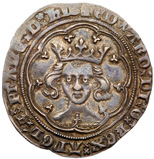 |
Edward III (1327-77), Silver Groat of Fourpence, Post-Treaty period (1369-77), London Mint. Variety with row of annulets at base of bust depicting chain mail, facing crowned bust within double tressure of nine arcs, trefoil on each cusp including breast, legend with inner and outer beaded border surrounding, double saltire stops, initial mark cross potent, +EDwardxx Dixx Gxx Rexxx AnGlxx Zxx FranCxx Dxx hIB, rev. long cross pattée, tri-pellets in each inner angle, double concentric legends with beaded inner and outer circles surrounding, some letters disjointed, CIVI TAS LON DON inner legend with unbarred A and reverse barred Ns, +Posvixx Devmx A DIVTOR Emx mEvmx, weight 4.68g (N.1286; S.1639). Toned, with an excellent depiction of King with "piercing eyes" coupled with the chain mail bust, almost extremely fine, a very rare variety. Value $2,000 - UP
The silver Groat of fourpence is once again the largest English silver coin from 1351 in the long reign of King Edward III. There are four main phases to the coinage all defined by changes to titling of the legends in relation to the Treaty of Bretigny signed in 1361 over claims to the Kingdom of France. This coin dates to the Post-Treaty phase where the claim to the French Kingdom is introduced once again. The chain mail depiction being a more intriguing variety only seen in this phase of the coinage at the London Mint.
The obverse Latin legend translates as "Edward by the grace of God, King of England and France, Lord of Ireland" and the reverse as "I have made God my helper" in the outer legend and "City of London" on the inner legend.
Ex Jeffrey J. North Collection. Ex Dr William J. Conte Collection, coin sold privately to Spink during 1997. Purchased from Spink and Son Ltd, 6th June 2001.
View details and enlarged photos
|
|
Lot 503 |
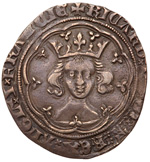 |
Richard II (1377-99), Silver Groat of Fourpence, type II. Facing crowned bust within double tressure of nine arcs, fleur on each cusp including breast, legend with inner and outer beaded circles surrounding, saltire stops, initial mark cross pattée, +RICARD'x Dixx Graxx Rexx AnGlxZx FranCIE, retrograde Z, rev. long cross pattée, tri-pellets in each inner angle, double concentric legends with beaded inner and outer circles surrounding, inner legend reads CIVI TAS LON DON, last N with contraction mark above, outer legend reads, +POSVI Devmxx A DIVTOR Emxx mEV, weight 4.49g (N.1320b; S.1679). Toned, a little uneven in shape as usual for these issues, a superb portrait piece of this very rare coinage, good very fine for issue, extremely rare. Value $5,000 - UP
Though the exact chronology is uncertain, there are four types defined of the silver coinage of King Richard II with the Groat being the largest coin, of which this is type 2 based on the style of the bust and the retrograde Z in legend.
The obverse Latin legend translates as "Richard by the grace of God, King of England and France" and the reverse as "I have made God my helper" in the outer legend and "City of London" on the inner legend.
Purchased from Spink and Son Ltd, 17th October 2002.
View details and enlarged photos
|
|
Lot 504 |
 |
Henry IV (1399-1413), Silver Groat of Fourpence, light coinage (1412-13). Primary series class III, London Mint, facing crowned bust in double tressure of nine arcs, annulet to left of crown, pellet to right of crown, trefoil on breast, fleurs on cusps, legend with double saltire stops, inner and outer beaded borders surrounding, initial mark cross pattée, trefoil at end of legend, +hEnRIC'x DEI xx GRA xx REX xx AnGL' xxZ' FranCxx+, rev. long cross pattée, tri-pellets in each inner angle, double concentric legends with beaded inner and outer circles surrounding, inner legend with reverse barred Ns and unbarred A, CIVI TAS LON DON, outer legend initial mark cross pattée, +POSVI x Devmxx A Dxx IVTOR Emxx mEvm, weight 3.74g (Potter III, dies 3/2 and plate VIII no.11 same dies; Stewartby p.323, PIII; N.1359b; S.1728). Attractively toned, a surprisingly well struck example of this usually poorly struck series, with a very crisp reverse, good very fine and extremely rare. Value $12,000 - UP
During the reign of King Henry IV there was a change in the weight standard of the gold and silver coinage toward the end of the reign partly as there was a shortage of bullion, and partly as a way to provide more revenue to the King. The newer lighter coinage ran from 1412 and have been classified into three types of which this coin herewith is the final type with a nine arc tressure around the portrait of the King.
The obverse Latin legend translates as "Henry by the grace of God, King of England and France" and the reverse as "I have made God my helper" in the outer legend and "City of London" on the inner legend.
Ex Motcomb Collection, Morton and Eden, Auction 78, 17th March 2016, lot 37. The most recent purchase in this collection.
View details and enlarged photos
|
|
Lot 505 |
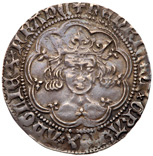 |
Henry V (1413-22), Silver Groat of Fourpence, class G. Facing crowned "frowning" bust within double tressure of nine arcs, fleur on each cusp including breast, legend with inner and outer beaded circles surrounding, saltire stops with serif letters, initial mark pierced cross with quatrefoil after King�s name, +hEnRIC+ DI�x GRA'x Rexx AnGliex Zx FranC, rev. long cross pattée, tri-pellets in each inner angle, double concentric legends with beaded inner and outer circles surrounding, inner legend reads, CIVI Tasxx Lon Donxx, outer legend initial mark cross pattée, ++POsvix Devmxx A DIVTOR Exx mEvm, weight 3.85g (N.1387a; S.1764). Toned, double struck on obverse, good very fine. Value $1,500 - UP
The silver coinage of King Henry V is of the same standard throughout the reign, and introduces a system of "privy marking" upon the coins, of which a great deal of classification has been determined. There are seven types in the gold and a smaller number in the silver, which for the Groats amounts to four types which correlate with the gold coins. So though this is type G, as that is how the companion gold coins are defined, there is no class D, E or F yet known for the silver Groat.
The obverse Latin legend translates as "Henry by the grace of God, King of England and France" and the reverse as "I have made God my helper" in the outer legend and "City of London" on the inner legend.
Ex James Fox Collection, Classical Numismatic Group, Auction 94, 18th September 2013, lot 1944. Ex A. H. Baldwin, Fixed Price List, Winter 2013, BH154.
View details and enlarged photos
|
|
Lot 506 |
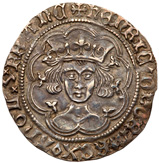 |
Henry VI, first reign (1422-61), Silver Groat of Fourpence, pinecone mascle issue (1430-34), Calais Mint. Facing crowned bust, within double tressure of nine arcs, fleur on six cusps, legend with inner and outer beaded circles surrounding, pinecone and mascle stops, initial mark cross patonce (1427-34), +hEnRIC� DI. GRA. REX<> AnGL'x Zx FranC, rev. long cross pattée, tri-pellets in each inner angle, double concentric legends with beaded inner and outer circles surrounding, pinecone and saltire stops, inner legend with terminal pinecone reads, VIL <>Laxx CALI SIE., outer legend initial mark plain cross, pinecone after first word, +POSVI. Devmxx A DIVTOR E'x mEvm, weight 3.70g (N.1461; S.1875). Attractively toned, with a great portrait, good very fine. Value $400 - UP
The Calais Mint in France had been operating for a number of years on and off since 1363, having reopened just before the end of the reign of Henry V, activity then extended through until a final closure in 1440. This coin was issued in the last decade of the Calais production and comes from the pinecone mascle issue, so-called on account of the symbols used in the legends.
The obverse Latin legend translates as "Henry by the grace of God, King of England and France" and the reverse as "I have made God my helper" in the outer legend and "Town of Calais" on the inner legend.
Purchased from Spink and Son Ltd, 23rd July 2003.
View details and enlarged photos
|
|
Lot 507 |
 |
Edward IV, first reign (1461-70), Silver Groat of Fourpence, heavy coinage (1461-64), type III, London Mint. Facing crowned bust, quatrefoil each side of neck, within double tressure of nine arcs, fleur on six cusps, blundered trefoil on breast, legend with inner and outer beaded circles surrounding, saltire stops, initial mark rose (1464-65), EDWARD'x Dix Grax REX'x AnGL'x Zx FranC, rev. long cross pattée, tri-pellets in each inner angle, double concentric legends with beaded inner and outer circles surrounding, inner legend reads CIVI TAS Lon Donxx, outer legend initial mark rose, POSVI Devm' A DIVTOR E' mEvm, weight 3.85g (N.1532; S.1973). Attractively toned, with a couple of rim imperfections, broadly struck with a very well-defined portrait, very pleasing, good very fine. Value $600 - UP
During the first reign of King Edward IV there was another adjustment in the weights of the coinage for both gold and silver in order to increase the bullion supply. The heavier standard only being current for the first three years of the reign, which have been divided into four classifications of the silver Groat, of which this is type III from the London Mint.
The obverse Latin legend translates as "Edward by the grace of God, King of England and France" and the reverse as "I have made God my helper" in the outer legend and "City of London" on the inner legend.
Ex Spink Coin Auction 1283, 3rd October 2001, lot 411.
View details and enlarged photos
|
|
Lot 508 |
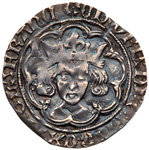 |
Edward IV or V (1483), Silver Groat of Fourpence, type XXII, Tower Mint London. Facing crowned bust within double tressure of nine arcs, fleur on six cusps, legend with inner and outer beaded circles surrounding, saltire stops, initial mark halved sun and rose both sides (1483), EDWRD�x Dix Grax Rexx AnGL'x Z FranCx, rev. long cross pattée, tri-pellets in each inner angle, double concentric legends with beaded inner and outer circles surrounding, CIVI TAS Lon Don inner legend, +POSVI Devm A DIVTOR E' mEvm, weight 3.04g (N.1631; S.2146A). Toned, a little uneven in shape and weak in parts, otherwise good fine to almost very fine and very rare. Value $4,000 - UP
The chronology of the gold coinage across the transition of the reigns of Edward IV and the "Prince in the Tower" King Edward V, have been worked out from documentary pipe-roll evidence at source. However, it is not clear cut with the silver coinage, and a chronology cannot be accurately worked out as to what belongs in the reign of late Edward IV or the short three-month reign of Edward under his uncle Richard III. The mint mark halved sun and rose certainly relates to this time period, and there are two varieties of obverse which either have or do not have a pellet under the bust. However, no documents seem to survive to tell us if this difference is significant to dating the coins to one reign or the other.
The obverse Latin legend translates as "Edward by the grace of God, King of England and France" and the reverse as "I have made God my helper" in the outer legend and "City of London" on the inner legend.
Ex Sotheby, May 2001, lot 712. Purchased from Spink and Son Ltd, 10rd May 2001.
View details and enlarged photos
|
|
Lot 509 |
 |
Richard III (1483-85), Silver Groat, type 2b. London Mint facing crowned bust in double tressure of nine arcs, fleur on six cusps, legend with inner and outer beaded circles surrounding, initial mark boars head 2, RICardx Dix Grax Rexxx AnGlx Z FranC, rev. long cross pattée, tri-pellets in each inner angle, double concentric legends with beaded inner and outer circles surrounding, initial mark boars head 2, inner legend with barred A, CIVI TAS Lon Don, outer legend surrounding, POSVI Devmxx A DIVTOR E' mEvm, weight 3.19g (N.1679; S.2156). Toned, fully round, weak in parts, a little double struck, otherwise good very fine and a rare variety. Value $5,000 - UP
For the near 26-month reign of Richard III there are three types of silver Groat from London, with the second type sub-divided into two, and the latter type being available additionally from the York Mint. There is also some sharing of dies between the types to further cloud the chronology, giving muling of mint marks, though the coin herewith is a straight-forward "boars head 2" both sides, which has a longer jaw than "boars head 1".
The obverse Latin legend translates as "Richard by the grace of God, King of England and France" and the reverse as "I have made God my helper" in the outer legend and "City of London" on the inner legend.
Ex Spink Numismatic Circular, February 2001, HS0114 also illustrated in color inside front cover.
View details and enlarged photos
|
|
Lot 510 |
 |
Henry VII (1485-1509), Silver Testoon of Twelve Pence, profile issue, type 1. Crowned bust facing right, all within linear and beaded circle only broken by cross atop ornate crown, legend and outer beaded border surrounding, initial mark small lis, hEnRIcvsx DI�x Grax REX, AnGliex Zx FR�, rev. quartered shield of arms over long cross fourchée, lis in each fork of cross which extend to outer border, legend with inner and outer beaded borders surrounding, initial mark small lis, POSVI DEV�x A DIVTO� E�x mEV�x, weight 9.07g (P&W dies 1/1; S.C.B.I. 23:759-760; Stewartby 1a, page 430; N.1740; S.2251). Traces of contemporary gilding both sides with associated surface marks, otherwise very fine with a great portrait, the key initial rarity to the Shilling series, with an excellent provenance, very rare. Value $25,000 - UP
The first silver Shilling issued in England, being the largest silver coin ever struck at that time, was also one of the first to adopt a realistic profile portrait of the monarch contemporary with the Renaissance artistic styles in Europe. As such these rare coins of King Henry VII have been highly coveted by numismatists through the ages, since not long after their inception in an indenture dated 20th November 1503 between the King and William Reed with Robert Fenrother. It is thought such pieces were engraved by Alexander de Brugsal, and as a larger silver denomination were influenced by the silver Teston in Europe which was first issued under the Duke of Milan in 1468. The Spink catalogue divided them into three main types of which the coin here is the earliest type and sub-class, as these types can be subdivided further. For further reading see "The Coinage of Henry VII continued" by W. J. W. Potter and E. J. Winstanley published in volume 31 of the British Numismatic Journal in 1962 and "A search into Rarity" by Colin Pitchfork in the Report of the Autralian Numismatic Society 1968 where he records 17 examples known of this type of which seven are in institutions as of that time.
The obverse Latin legend translates as "Henry by the grace of God, King of England and France" and the reverse as "I have made God my helper.".
Originally sourced from "an old collection in Holland" Ex Harry Alexander Parsons, Glendining 11-13th May 1954, lot 328. Ex C. J. Firth Collection, sold anonymously in Spink Coin Auction 1, 11th October 1978, lot 183, front cover coin, sold £8,500. Ex Spink Coin Auction 55, 8th October 1986, lot 123. Ex Lucien La Riviere, Spink Coin Auction 124, 18-19th November 1997, lot 1726. Ex Martin Hughes Collection, Spink Coin Auction 139, 16th November 1999, lot 1. Ex Spink Numismatic Circular, August 2000, 3032.
View details and enlarged photos
|
|
Lot 511 |
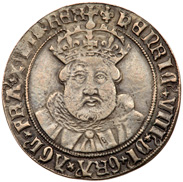 |
Henry VIII (1509-47), debased Silver Testoon of Twelve Pence, Tower Mint, third coinage (1544-47). Facing crowned bust of King in ruff, legend and beaded borders surrounding, cross on crown breaks inner border both sides, initial mark lis, lombardic lettering with slipped trefoil stops, hEnRIC'x VIII'x DEI'x GRA'x AGL'x FRA'x Zx HIB'x REX, rev. crowned Tudor rose, crowned h to left, crowned R to right, legend with Roman style lettering and beaded borders surrounding, double slipped trefoil stops, initial mark lis with terminal mark lis, +Posvixx Devmxx ADIVTOrivmxx Mevmxx+, weight 7.43g (Stewartby type A, page 525; N.1841; S.2364). Toned, well centred and exceptionally well struck for this earlier issue of the Testoon, unusual reverse die with the two lis mint marks, great detail on the Tudor rose, but especially on the "Holbein style" bust, almost extremely fine and extremely rare this well preserved. Value $15,000 - UP
Struck in the period of debasement of the coinage, when the King took more profit from the coinage to help pay for the upkeep of his armies on the continent and for his extravagant taste and spending, earning him the nickname "Old Copper-nose" in direct relation to these Testoon coins, as the first place any base metal would show through was upon the high point of the nose. The coin offered herewith seems to be one of the earlier issues with a better silver content than the latter pieces, demonstrating the VIII Roman numerals legend and the lis mint mark which appears twice on the reverse side.
For further reading see "The coinages of Henry VIII and Edward VI in Henry's Name" by C. A. Whitton in the British Numismatic Journal volume 26, 1949.
The abbreviated Latin legends translate as on the obverse "Henry the Eighth by the Grace of God, King of England, France and Ireland"; and on the reverse "I have made God my helper."
Ex. 4th Earl of Pomfret (d.1833), coin collection sold privately post mortem to London dealer Harry Osborn Cureton.
Ex. James Gibbs (d.1886), collection purchased by Spink and Son Ltd before 1891.
Ex. Adam Black Richardson, Sotheby, 22nd May 1895, lot 119, sold for £5/10/-.
Ex. John Gloag Murdoch, first portion, Sotheby, 31st March 1903, lot 444, sold for £12.
Ex. Frederick George Hilton-Price, Sotheby, 17-19th May 1909, lot 96.
Ex. Roger Shuttlewood, Spink Coin Auction 151, 15th March 2001, lot 155.
This coin also illustrated in Antiques Trade Gazette, Coins and Medals column by Richard Falkiner, 21st April 2001.
View details and enlarged photos
|
|
Lot 512 |
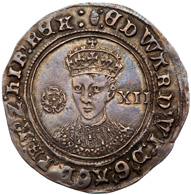 |
Edward VI (1547-53), fine Silver Shilling of Twelve Pence, third period (1551-53). Facing crowned bust, rose to left, value to right, legend with inner linear and beaded circles surrounding, initial mark tun, outer beaded border around rim both sides, :EDWARD; VI. D; G; AGL; FRA; Z. hIB; REX:, rev. long cross fourchée over quartered shield of arms, legend with inner linear and beaded circles surrounding, POSVI DEV.' A DIVTOR E; mEV;�, weight 5.81g (N.1937; S.2482). Attractively toned, well struck on a broad flan, exceptionally detailed portrait of the boy King, good very fine. Value $1,500 - UP
The fine silver issues were struck during the third period of the coinage of the boy King Edward VI, and were produced in the purest silver for the Tudor period which also saw the introduction of the denominations of Crown, Halfcrown, Sixpence and Threepence. Incidentally the first dated coins in a non-Roman numeral format first appear in this coinage on the larger two denominations. Because the Crowns and Halfcrowns show the King only at a distance on horseback, the Neil Smith Collection therefore contains the largest silver coin with Edward�s bust portrait which was featured upon the silver Shilling.
The abbreviated Latin legends translate as on the obverse "Edward the Sixth by the Grace of God, King of England, France and Ireland"; and on the reverse "I have made God my helper."
Ex Roger Shuttlewood, Spink Coin Auction 151, 15th March 2001, lot 270.
View details and enlarged photos
|
|
Lot 513 |
 |
Ireland, Mary (1553-54), Silver Shilling of Twelve Pence, dated 1553 in Roman numerals. Crowned bust left, legend with inner and outer beaded circles surrounding, mint mark lis after Queen�s name, double annulet stops, mARIA:+: D: G: AnG: FRA: Z: hIB: ReginA:, rev. crowned harp of ten strings, crowned M to left, crowned R to right, legend with inner and outer beaded circles surrounding, mint mark lis after first word and date in Roman numerals, double annulet stops, VERITAS:+: TEMPORIS: FILIA: M: D: LIII., weight 5.77g (D&F 224; S.6495). Toned, some light weaknesses to strike and one tiny rim chip at top, otherwise with an excellent depiction of the Queen, the largest portrait bust of her upon a coin, extremely fine for issue, extremely rare this well preserved. Value $7,500 - UP
This is the only non-English coin in the Neil and Gina Smith Collection, because the largest numismatic bust portrait of Bloody Mary available is upon the Irish Shilling. The largest English bust portrait of Mary Tudor is upon the silver Groat which is of course a smaller coin. The Irish portrait Shilling is a key rarity in that series being dated in Roman numerals in the obverse legend and is the earlier of the two possible dates for the reign.
The Irish issue is a key rarity in the Tudor series for Ireland and extremely hard to find in a higher grade of preservation like we have demonstrated herewith.
The abbreviated Latin legends translate as on the obverse "Mary by the Grace of God, Queen of England, France and Ireland"; and on the reverse "Truth, the daughter of Time."
Ex H. C. Dangar, Glendining, 15-16th April 1953, lot 422 pt. Ex Rev. Arnold Mallinson, Spink Coin Auction 39, 6th December 1984, lot 143. Ex H Lakin. Purchased from Spink and Son Ltd, 6th June 2001.
View details and enlarged photos
|
|
Lot 514 |
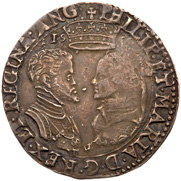 |
Philip & Mary (1554-1558), Silver Shilling of Twelve Pence, 1555. With English title only, profile busts facing each other, crown above with date split either side, legend with inner linear and outer beaded border surrounding, PHILIP. ET. MARIA. D. G. REX. ET. REGINA. ANG., rev. crowned quartered shield of arms, value either side of crown, legend and beaded border surrounding.POSVIMVS. DEVM. ADIVTOREM. NOSTRVM., weight 6.20g (N.1968; S.2501). Toned, with one light crease evident both sides, slight weakness to rear of Mary�s portrait, Philip much bolder, the 55 of date weak but visble, otherwise very fine. Value $2,000 - UP
The coinage of Philip and Mary is the first time a King and Queen had appeared together on a coin since a Stephen Penny issued with Queen Matilda in the twelfth century, albeit they were two standing figures. The Philip and Mary Shilling is the largest coin to depict the King and Queen appearing in profile facing each other. This coin is the scarcer 1555 issue with the English titles only in the legend.
The Latin legends translate as on the obverse "Philip and Mary by the Grace of God, King and Queen of England, " and on the reverse "We have made God our helper."
Purchased from Spink and Son Ltd, 15th March 2001.
View details and enlarged photos
|
|
Lot 515 |
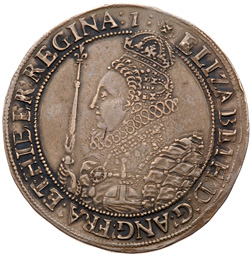 |
Elizabeth I (1558-1603), Silver Crown. Ornate crowned bust left, holding orb and sceptre, crown breaks inner beaded circle, initial mark 1 (1601), legend with inner and outer beaded border surrounding, ELIZABETH: D: G: ANG: FRA: ET: HIBER: REGINA:1:, rev. long cross fourchée under quartered shield of arms, legend with inner and outer beaded border surrounding, :1: POSVI: DEVM: AD IVTORE M: MEVM:, weight 29.89g (Cooper dies C/2a; KM.7; N.2012; S.2582). Toned, just a few light striations and short black mark on chin, a little double-struck evident in the legends, the portrait consequently quite pleasing, otherwise almost extremely fine. Value $12,500 - UP
The Elizabeth I silver Crown represents the largest numismatic portrait of the Tudor series with the elaborate bust of the Queen facing left holding a sceptre. The silver Crowns were struck toward the end of the reign of Elizabeth I in the last issue of her coinage. They are dated by the mint marks which are 1 for 1601, or 2 for 1602 in the Julian calendar in use at that time. F. R. Cooper studied the coinage in depth throughout the 1960s and produced his synopsis of the coinage referenced above, published through the Spink Numismatic Circular in June 1971. Interestingly this exact reverse die was not known to Cooper in 1971 with the beading and lettering so arranged. However, it became known as reverse 2a by the time of the sale of his collection in the late 1970s which contained an example coupled with obverse B. All the known examples of reverse 2a of which there are less than ten known in total are coupled with obverse A or obverse B. This is the only known example so far to be coupled with obverse C making it a very unusual coin of the highest rarity.
The abbreviated Latin legends translate as on the obverse "Elizabeth by the Grace of God, Queen of England, France and Ireland"; and on the reverse "I have made God my helper."
Ex Edward D. J. Van Roekel Collection, Spink Coin Auction 156; 15th November 2001, lot 4.
View details and enlarged photos
|
|
Lot 516 |
 |
James I (1603-25), Silver Piedfort Sixpence, struck on a heavy flan, 1623, third coinage (1619-25). Sixth crowned bust right, value behind, legend with inner and outer beaded border surrounding, initial mark thistle (1621-23) both sides, IACOBVS D: G: MAG: BRI: FRA .ET HIB REX, rev. date above quartered shield of arms, legend with inner and outer beaded border surrounding, QVÆ DEVS CONIVNXIT NEMO SEPARET, weight 6.06g (cf.KM.77; N.2124; S.2668). Slightly double struck, toned, almost extremely fine, one of only three heavy flan pieces dated 1623 known and the best preserved, extremely rare. Value $5,000 - UP
Only four examples of heavy flan Sixpences are known of James I in total, the fourth coin is an example dated 1622. Though the Sixpence is the second largest bust portrait coin of this reign after the Shilling, it was the wonderful state of preservation and the extreme rarity of such a heavy flan portrait piece, that made this an attractive addition to the Neil and Gina Smith Collection. Such pieces were thought to have been made bespoke for special presentation.
The abbreviated Latin legends translate as on the obverse, "James, by the grace of God, King of Great Britain, France and Ireland," and on the reverse "What God hath joined together let no man put asunder."
Ex Roger A. Shuttlewood Collection of Sixpences of James I, Spink Numismatic Circular, February 2001, HS0169, also illustrated in color inside front cover.
View details and enlarged photos
|
|
Lot 517 |
 |
Charles I (1625-49), Silver Pattern Crown of Five Shillings, engraved by Nicholas Briot. Bare headed draped bust left, legend surrounding with inner linear and outer beaded borders, lozenge stops, initial mark flower, CAROLVS. D: G. MAG. BRITANNIÆ. FRAN. ET. HIB. REX. FIDEI. DEFENSOR, rev. armoured King on horseback riding left, with flowing sash and upright sword, stony ground below, small .B. below raised front hoof, legend commencing lower left surrounding with outer beaded border, lozenge stops.HAVD. VLLI. VETERVM. VIRTVTE. SCEVNDVS., weight 19.47g (Brooker 1248 this coin; N.2670). One of only four known examples, has been once gilt with some light tooling striations, some light rim bruises and a couple of digs in fields otherwise very fine and of the highest rarity with an impeccable provenance. Value $15,000 - UP
This intriguing design has always been classed as a pattern for a Crown by virtue of its reverse design and diameter, though the weight is much lighter than a crown would traditionally be. This is certainly the largest bust portrait coin of King Charles I, with Crown size pieces of the Stuart period usually showing a King on horseback like the reverse on this piece. The detail of the design is an amazing example of numismatic portraiture by the Frenchman Nicholas Briot (c.1579-1646) whose first Patent was dated the 16th December 1628 as sole designer of the effigies for the regal coinage with pay backdated to the autumn of 1626.
For further reading about Nicholas Briot see the "John Brooker Collection Coins of Charles I" in the sylloge series, section on page xxvi in the chapter on the "Coinage at the Tower Mint" by J. P. C. Kent and in the chapter entitled "The Patterns" on page xlvii by P. J. Preston-Morley.
The abbreviated Latin legends translate as on the obverse, "Charles, by the grace of God, King of Great Britain, France and Ireland, Defender of the Faith" and on the reverse "not second in valour to any of the ancient heroes.".
Ex William Simonds Higgs, Sotheby, 29th April 1830, lot 286. Ex James Dodsley Cuff, Sotheby, 26th June 1854, lot 1213, sold for £20. Ex John Alfred Wigan and Edward Wright Wigan Collection, purchased post mortem by Rollin and Feuardent, 1872. Ex James Halliburton Young, Sotheby, 7th April 1881, lot 250. Ex George William Egmont Bieber, Sotheby, 13th May 1889, lot 190. Ex John Gloag Murdoch, Second Portion, Sotheby, 8-13th June 1903, lot 294, sold for £61 where noted that the Mr Cuff had the gilding removed in the near quarter-century he owned it, illustrated on plate IX. Ex Dr Thomas Wakley Jr., Sotheby, 6th December 1909, lot 97. Ex Cumberland Clark, part 2, Sotheby, 22-23rd January 1914, lot 105. Ex Herbert Muspratt Lingford, part I, Glendining, 24th October 1950, lot 135, sold for £80. Ex W. Bertram Thorpe, Fine Crown Pieces, Spink Numismatic Circular, March 1951, item 2865 offered at £85. Ex John Godfrey Brooker, S.C.B.I. 33:1248, collection sold by Spink and Son from 1978. Ex Lord Rodney Smith of Marlow, second collection sold to Spink circa 1983. Ex Herman Selig Collection, part I, Spink Coin Auction 70, 31st May 1989, lot 216. Ex Paul Karon, Spink Coin Auction 129, 17th November 1998, lot 81. Ex Spink Numismatic Circular, June 2000, lot 2330.
View details and enlarged photos
|
|
Lot 518 |
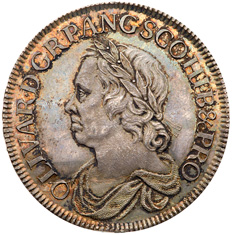 |
Oliver Cromwell (d.1658), Silver Crown of Five Shillings, 1658, 8 in date struck over 7. Engraved by Thomas Simon, laureate and draped bust left, raised die flaw at early stage, legend and outer toothed border surrounding, OLIVAR. D.G.R.P. ANG. SCO. HIB &c PRO, rev. crowned quartered shield of arms of the Protectorate, date above, legend and outer toothed border surrounding, PAX QVÆRITVR BELLO, edge inscribed in raised letters, *.HAS. NISI. PERITVRVS. MIHI. ADIMAT. NEMO., weight 30.10g (L&S 1; Bull 240; ESC 10; KM.D207; S.3226). Toned with some light blemishes on obverse, just a few very light hairlines, die flaw at mid-stage with some contemporary adjustment across portrait, otherwise with excellent detail especially in the hair, good extremely fine. Value $8,000 - UP
The largest portrait coin of Oliver Cromwell is the magnificent silver Crown engraved by Thomas Simon. However, not long after striking commenced a crack started to emerge on the lower left side of the obverse die, progressing across the horizontal of the neck of Cromwell. This crack in the die manifests on the struck coins as a raised die flaw across the obverse, which would have been a major problem upon the freshly struck coins at the time. It is thought that many of the coins were worked upon with fine tooling to have the die flaw adjusted as much as possible, resulting in making them perhaps suitable for presentation. The inscription on the edge produced using the new technology of Pierre Blondeau and his castaing machine was a safeguard against the illegal practice of clipping, and was severe in its intent as the Latin translates as "Let no one remove these from me under penalty of death."
The abbreviated Latin legends translate as "Oliver by the Grace of God, Protector of the Republic of England, Scotland and Ireland," and on the reverse "Peace is sought by war."
Provenance:Purchased from Spink and Son Ltd, 30th June 2001.
View details and enlarged photos
|
|
Lot 519 |
 |
Charles II (1660-85), Silver Halfcrown of Thirty Pence, third hammered issue (1661-62). Crowned bust left, mark of value XXX behind in field, legend with inner and outer toothed border surrounding, initial mark crown both sides, CAROLVS. II. D: G. MAG: BR FR: ET. HIB: REX, rev. long cross fourchée over quartered shield of arms, legend with inner and outer toothed border surrounding.CHRISTO. AVSPICE. REGNO. Weight 14.67g (Bull 301; ESC 456; N.2761; KM.410; S.3321). Attractively toned, well centred and amazingly well struck for this hammered issue, amongst the best examples available, good extremely fine for issue and extremely rare. Value $10,000 - UP
Interestingly the Neil and Gina Smith collection contains a superb example of the last issue of the hammered silver Halfcrown, the largest portrait piece from his hand-struck coinage; rather than going for the later larger machine-made portrait facing the other direction on the milled Crown. The earlier hammered coinage being the preferred portrait as the work of Thomas Simon rather than the Roettier Brothers, the joint engravers of the milled pieces.
The abbreviated Latin legends translate as on the obverse "Charles by the Grace of God, King of Great Britain, France and Ireland"; and on the reverse "I reign under the auspice of Christ."
Ex George Hamilton-Smith, Glendining, 23-25th May 1927, lot 419, sold for £6. Ex Harrington Manville Collection, 12th July 2001, lot 66, illustrated on front cover. Purchased from Spink and Son Ltd, 12th July 2001.
View details and enlarged photos
|
|
Lot 520 |
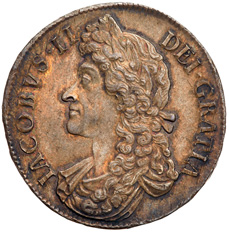 |
James II (1685-88), Silver Crown of Five Shillings, 1688. Second laureate and draped bust left, legend and outer toothed border surrounding, IACOBVS. II. DEI. GRATIA, weak stop after DEI, rev. crowned cruciform shields, garter star at centre, eight strings to Irish harp, date either side of top crown, legend and outer toothed border surrounding, MAG. BR. FRA. ET. HIB REX., edge inscribed in raised letters, +.DECVS. ET. TVTAMEN. ANNO. REGNI. QVARTO+, weight 30.06g (Bull 746; ESC 80; KM.463; S.3407). Attractively toned, just a little weakly struck on highest points both sides, a pleasing coin, good extremely fine. Value $6,000 - UP
The last date for the coinage of James II was 1688 as we have demonstrated herewith, the bust being the second type of the reign by Roettier.
The Latin legends translate as on the obverse "James the Second, by the grace of God," and on the reverse, "King of Great Britain, France and Ireland," additionally on the edge "An ornament and a safeguard, in the fourth year of the reign."
Ex A. H. Baldwin, purchased December 1977. Ex Edward D. J. Van Roekel Collection, Spink Coin Auction 156; 15th November 2001, lot 142.
View details and enlarged photos
|
|
Lot 521 |
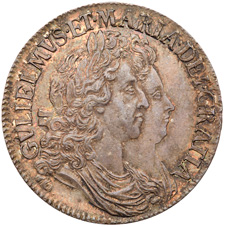 |
William and Mary (1688-94), Silver Crown of Five Shillings, 1691. Conjoined draped busts right, legend and outer toothed border surrounding, GVLIELMVS. ET. MARIA. DEI. GRATIA, rev. crowned cruciform shields, eight strings to Irish harp, WM monogram in angles, date surrounding Lion of Nassau at centre, legend and outer toothed border surrounding, MAG. BR FR. ET. HI. REX. ET. REGINA., edge inscribed in raised letters and dated, +.DECVS. ET. TVTAMEN. ANNO. REGNI. TERTIO.+., weight 30.07g (Bull 820; ESC 82; KM.478; S.3433). Toned, extremely fine and rare to find so nicely preserved. Value $6,000 - UP
The conjoined profile busts of William and Mary together appear facing right on this the largest silver coin of the reign engraved by the Roettier brothers, James and Norbert. The silver coins of this reign are unusual in that the date reads around the central device of the reverse, being the Lion of Nassau relating to the lineage of William of Orange. This is the first date for the silver Crown in the reign which also features WM monogram in each of the angles of the reverse.
The Latin legends translate as on the obverse "William and Mary by the Grace of God," and abbreviated on the reverse as "King and Queen of Great Britain, France and Ireland," additionally on the edge "An ornament and a safeguard, in the third year of the reign."
Ex Roger Shuttlewood Collection of British Milled Silver, Spink Numismatic Circular, April 2001, MS0733.
View details and enlarged photos
|
|
Lot 522 |
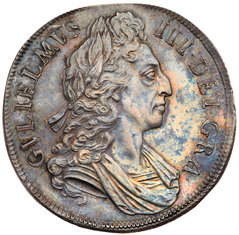 |
William III (1694-1702), Silver Proof Crown of Five Shillings, 1696. Third laureate and draped bust right, legend and outer toothed border surrounding, GVLIELMVS. III. DEI. GRA., rev. crowned cruciform shields, shields with indented tops, eight strings to Irish harp, Lion of Nassau at centre, date either side of top crown, legend and outer toothed border surrounding.MAG. BR.FRA. ET.HIB. REX. edge plain, weight 29.57g (Bull 1008 R4; ESC 95 R4; L&S 4; S.3472). Attractively toned, struck a little off-centre and ovoid in shape, otherwise practically as struck, good extremely fine and extremely rare. Value $15,000 - UP
It is interesting to note the unusual shields on the reverses of the first and third bust proofs dated 1696 have indented tops, a precursor of what was to follow from 1697 in currency. The 1695 first bust proof and the pattern or proof second bust Crowns of 1696 have the earlier shield arrangement. The harp depiction is also unique to the proof and in the style of the early harp as used on currency of 1695-96 period, but not the same. The Lion of Nassau has a different pattern of the nine billets surrounding with the head between billets rather than below.
The third bust proof as seen here, maybe rarer than the first bust proofs of 1695 and 1696, as we have not traced another of the third bust for sale in public auction since this actual coin was last sold in the Van Roekel Collection in 2001.
The Latin legends translate as on the obverse "William III by the Grace of God," and abbreviated on the reverse as "King of Great Britain, France and Ireland."
Ex Dr David Rees-Jones Collection, Spink Coin Auction 117, 19th November 1996, lot 138. Ex Edward D. J. Van Roekel Collection, Spink Coin Auction 156; 15th November 2001, lot 159, illustrated on colour plate.
View details and enlarged photos
|
|
Lot 523 |
 |
Anne (1702-14). Silver Crown of Five Shillings, Pre-Union type, 1703, VIGO. Below draped bust left, legend and outer toothed border surrounding, ANNA.DEI. GRATIA., rev. Pre-Union crowned cruciform shields, seven strings to Irish harp, garter star at centre, date either side of top crown, legend and outer toothed border surrounding.MAG BR. FRA. ET. HIB REG., edge inscribed in raised letters.+. DECVS. ET. TVTAMEN. ANNO. REGNI. TERTIO, weight 29.85g (Bull 1340; ESC 99; KM.519.1; S.3576). Toned, well struck with just a few tiny flecks and spots with a hint of adjustment on reverse, good extremely fine and on par with the finest examples available, rare thus. Value $20,000 - UP
The most intrepid of stories lays behind the capture of the Vigo treasure as opposed to the other companies or privateers who had their mark placed upon the coins in other reigns. The Battle of Vigo Bay occurred on 23rd October 1702 and it was after the Battle that the treasure largely of silver with a tiny proportion of gold, was captured and transported back to Southampton on the south coast of England. From there the treasure was brought with great pomp and ceremony to London, overseen by the Mint Master himself, one Mr Isaac Newton, to then be turned into coinage at the Royal Mint in the Tower of London. The treasure consisted of absolutely thousands of pounds in weight of silver, but a mere seven pounds and eight ounces of gold.
The Latin legends translate as on the obverse "Anne by the Grace of God," and abbreviated on the reverse as "Queen of Great Britain, France and Ireland," additionally on the edge "An ornament and a safeguard, in the third year of the reign."
Ex Spink and Son Ltd sold privately 1994. Purchased by Bruce Lorich circa 1995-96, USA. Purchased by Spink from Bruce Lorich at the New York International Coin Convention, December 2000. Purchased from Spink and Son Ltd, 12th March 2001.
View details and enlarged photos
|
|
Lot 524 |
 |
George I (1714-27), Silver Crown of Five Shillings, 1718., 8 struck over 6 in date. Laureate and draped bust right, legend and outer toothed border surrounding, GEORGIVS. D. G. M. BR. FR. ET. HIB. REX. F. D., rev. crowned cruciform shields, eleven strings to Irish harp, garter star at centre, roses and plumes in alternate angles, date either side of top crown, legend and outer toothed border surrounding.BRVN. ET. L. DVX S.R.I.A:TH ET. EL., edge inscribed in raised letters of inverted orientation to obverse, note use of letter U in edge wording, +.DECUS. ET. TUTAMEN+ ANNO. REGNI. QUINTO. (Bull 1542 R; ESC 111A; S.3639; KM.545.1). Toned, well struck with excellent detail to obverse, a pleasing extremely fine, rare so well preserved. Value $7,500 - UP
The 1718 Crown is the second of five dates of Crown for this reign and features the roses and plumes alternating in the reverse angles, which indicated a mixed source of the silver metal used to strike the coinage from both England and Wales. The abbreviated Latin legends translate as on the obverse "George by the Grace of God, King of Great Britain, France and Ireland, Defender of the Faith" continuing on the reverse in abbreviated Latin which if in shown in full reads "Brun et Lunebergen-sis Dux, Sacri Romani Imperii Archi-Thesaurius et Elector" and translates as "Duke of Brunswick and Luneberg, High Treasurer and Elector of the Holy Roman Empire," additionally on the edge "An ornament and a safeguard, in the fifth year of the reign."
Ex Spink and Son Ltd, purchased October 1979. Ex Edward D. J. Van Roekel Collection, Spink Coin Auction 156; 15th November 2001, lot 175.
View details and enlarged photos
|
|
Lot 525 |
 |
George II (1727-60), Silver Proof Crown of Five Shillings, 1732. Young laureate and draped bust left, legend and outer toothed border surrounding, GEORGIVS. II DEI. GRATIA., rev. crowned cruciform shields, ten strings to Irish harp, garter star at centre, roses and plumes in alternating angles, date either side of top crown, legend and outer toothed border surrounding, M. B. F. ET. H. REX. F. D. B. ET. L. D. S. R. I. A. T. ET. E., edge striated plain, weight 29.47g (ESC 118 R3; Bull 1661; L&S 6; KM.575.1; S.3686). Dark attractive tone, just a few very light blemishes in toning, one tiny reverse rim nick, otherwise good extremely fine, with a good provenance, very rare this nice. Value $15,000 - UP
The 1732 Proof Crown was struck with special care and attention to a finer work standard as a presentation example of the first silver Crown and largest silver numismatic portrait of the reign. The coin features the roses and plumes alternating in the reverse angles, which indicated a mixed source of the silver metal used to strike the coinage from both England and Wales.
The Latin legends translate to on obverse "George II by the Grace of God" continuing on the reverse in abbreviated Latin which if in shown in full reads "Magnae Britanniae Franciae et Hiberniae Rex Fidei Defensor Brun et Lunebergen-sis Dux, Sacri Romani Imperii Archi-Thesaurius et Elector" and translates as "King of Great Britain, France and Ireland, Defender of the Faith, Duke of Brunswick and Luneberg, High Treasurer and Elector of the Holy Roman Empire."
Ex U.B.S., Switzerland, Auction 47, 17th September 1999, lot 1556. Ex Edward D. J. Van Roekel Collection, Spink Coin Auction 156; 15th November 2001, lot 182.
View details and enlarged photos
|
|
Lot 526 |
 |
George III (1760-1820), Silver Crown of Five Shillings, 1818 LVIII. Laureate head right, engraved by Benedetto Pistrucci, PISTRUCCI below truncation, date below, legend and outer toothed border surrounding, GEORGIUS III D: G: BRITANNIARUM REX F: D:, rev. St George and dragon right, PISTRUCCI in exergue, Order of the Garter motto in French surrounding.HONI. SOIT. QUI. MAL. Y. PENSE., outer toothed border surrounding rim, edge inscribed in raised letters, DECUS ET TUTAMEN* ANNO REGNI LVIII*, weight 28.31g (Bull 2005; Davies 1; ESC 211; KM.675; S.3787). Toned with blemishes, otherwise practically as struck, uncirculated. Value $1,750 - UP
Perhaps the favourite coin of William Wellesley Pole the Master of the Mint at this time and older brother of the Duke of Wellington, the silver Crowns engraved by Italian engraver Benedetto Pistrucci were released with a glowing sense of pride in that Pole ordered that each piece was wrapped in tissue paper before being sent out to the banks for circulation. Considered as a piece of numismatic art by Pole who had made the sometime fiery Pistrucci the Chief Engraver in all but name as an Italian could not hold such an office in the Royal Mint officially at that time, the name of the engraver features prominently in full on both sides of the coin.
The Latin legend translate as on the obverse "George the Third, by the grace of God, King of the Britons, Defender of the Faith" and the French on the reverse, "Evil to him who evil thinks," additionally on the edge "An ornament and a safeguard, in the 58th year of the reign".
Ex Edward D. J. Van Roekel Collection, Spink Coin Auction 156; 15th November 2001, lot 194.
View details and enlarged photos
|
|
Lot 527 |
 |
George IV (1820-30), Silver Pattern Crown of Five Shillings, 1825. Engraved by William Wyon, bare head left, date below with rosette stops flanking, legend and outer toothed border with raised rim surrounding, GEORGIUS IV DEI GRATIA, rev. crowned and crested helmet over quartered shield of arms, with a crowned escutcheon of the Arms of Hanover, French language motto on banner below DIEU ET MON DROIT, legend and outer toothed border surrounding, BRITANNIARUM REX FID: DEF:, edge inscribed in raised letters, DECUS ET TUTAMEN* ANNO REGNI SEPTIMO, weight 28.15g (L&S 20; Bull 2331 R3; ESC 255 R3; Davies 150; KM.Pn90; S.3806). Attractively toned with some mottling, practically as struck, mint state and very rare. Value $20,000 - UP
The new Chief Engraver of coins at this time, William Wyon produced his first proof designs for coinage with the 1825-26 issues, of which this Crown is an initial example of the mastery of his engraving technique. The 1825 proof issue is much rarer and are infrequently available, compared to the 1826 Proof Crown which was issued a year later for the proof set in larger numbers.
The Latin legend translate as on the obverse "George the Fourth, by the grace of God" and on the reverse as "King of the Britons, Defender of the Faith" with the French language garter motto as "God and my right.".
Ex Spink and Son Ltd, purchased 27th December 2000.
View details and enlarged photos
|
|
|
|